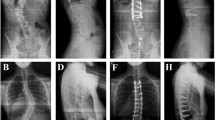Abstract
Background
Are obese patients with idiopathic scoliosis undergoing spinal surgery at higher risk for perioperative complications? This is not clearly understood. One previous study showed a greater preoperative thoracic kyphosis but no increase in perioperative complications.
Questions/purposes
We asked whether obese adolescents with idiopathic scoliosis have more perioperative complications and decreased curve correction.
Methods
We retrospectively reviewed 478 patients with idiopathic scoliosis operated on from 1998 to 2010. There were 236 (187 females, 49 males) with a mean age of 14 years (range, 11–22 years) who met the inclusion criteria. Demographic data, radiographic measurements, perioperative data, and major and minor complications were recorded. The BMI percentile (BMI%) defined two patient groups: healthy weight (BMI% < 85) (n = 181) and obese (BMI% ≥ 85) (n = 55). The preoperative curves were similar in the two groups. Minimum followup was 2 years (mean, 6 years; range, 2–14 years).
Results
Postoperatively, the mean major curve was smaller for healthy-weight patients (20°; range, 8°–36°) than for obese patients (23.2°; range, 12°–56°), as was the mean kyphosis (31.1° [range, 10°–56°]) versus 36° [range, 15°–33°], respectively). The postoperative lordosis was similar in both groups. Increased BMI% correlated with increased operative time, intraoperative blood loss, amount of intraoperative crystalloids, and difficulty with administration of spinal anesthesia.
Conclusions
Obese patients are at higher risk for perioperative complications when undergoing spinal deformity surgery. Counseling should be done with the patient and family and weight loss recommended before surgery.
Level of Evidence
Level IV, prognostic study. See Instructions for Authors for a complete description of levels of evidence.
Similar content being viewed by others
References
Bamgbade OA, Rutter TW, Nafiu OO, Dorje P. Postoperative complications in obese and nonobese patients. World J Surg. 2007;31:556–560, discussion 561.
Batia NN, Pirpiris M, Otsuka NY. Body mass index in patients with slipped capital femoral epiphysis. J Pediatr Orthop. 2006;26:197–199.
Choban PS, Weireter LJ Jr, Maynes C. Obesity and increased mortality in blunt trauma. J Trauma. 1991;31:1253–1257.
de Sa Pinto AL, de Barros Holanda PM, Radu AS, Villares SM, Lima FR. Musculoskeletal findings in obese children. J Paediatr Child Health. 2006;42:341–344.
Dindo D, Muller MK, Weber M, Clavien PA. Obesity in general elective surgery. Lancet. 2003;361:2032–2035.
Guo SS, Wu W, Chumlea WC, Roche AF. Predicting overweight and obesity in adulthood from body mass index values in childhood and adolescence. Am J Clin Nutr. 2002;76:653–658.
Hod-Feins R, Abu-Kishk I, Eshel G, Barr Y, Anekstein Y, Mirovsky Y. Risk factors affecting the immediate postoperative course in pediatric scoliosis surgery. Spine (Phila Pa 1976). 2007;32:2355–2360.
Karunakar MA, Shah SN, Jerabek S. Body mass index as a predictor of complications after operative treatment of acetabular fractures. J Bone Joint Surg Am. 2005;87:1498–1502.
Kopelman PG. Obesity as a medical problem. Nature. 2000;404:635–643.
Kroonen LT, Herman M, Pizzutillo PD, Macewen GD. Prader-Willi syndrome: clinical concerns for the orthopaedic surgeon. J Pediatr Orthop. 2006;26:673–679.
LeBlanc R, Labelle H, Forest F, Poitras B. Morphologic discrimination among healthy subjects and patients with progressive and nonprogressive adolescent idiopathic scoliosis. Spine (Phila Pa 1976). 1998;23:1115–1116.
LeBlanc R, Labelle H, Rivard CH, Poitras B. Relation between adolescent idiopathic scoliosis and morphologic somatotypes. Spine (Phila Pa 1976). 1997;22:2532–2536.
Manoff EM, Banffy MB, Winell JJ. Relationship between body mass index and slipped capital femoral epiphysis. J Pediatr Orthop. 2005;25:744–746.
McKee MD, Waddell JP. Intramedullary nailing of femoral fractures in morbidly obese patients. J Trauma. 1994;36:208–210.
Mogul HR, Rau J, Weinstein BI, Zhang S, Peterson SJ. New perspectives on diagnosis and treatment of obesity. Heart Dis. 1999;1:295–304.
Mokdad AH, Ford ES, Bowman BA, Dietz WH, Vinicor F, Bales VS, Marks JS. Prevalence of obesity, diabetes, and obesity related health risk factors, 2001. JAMA. 2003;289:76–79.
Pirpiris M, Jackson KR, Farng E, Bowen RE, Otsuka NY. Body mass index and Blount disease. J Pediatr Orthop. 2006;26:659–663.
Upasani VV, Caltoum C, Petcharaporn M, Bastrom T, Pawelek J, Marks M, Betz RR, Lenke LG, Newton PO. Does obesity affect surgical outcomes in adolescent idiopathic scoliosis? Spine (Phila Pa 1976). 2008;33:295–300.
Acknowledgments
The authors thank Parianne Fatica, BA, for her assistance with the preparation of this manuscript.
Author information
Authors and Affiliations
Corresponding author
Additional information
One or more of the authors (GHT) certifies that he is an unpaid consultant for SpineForm LLC (Cincinnati, OH, USA), OrthoPediatrics Corp (Warsaw, IN, USA), and K2 M, Inc (Leesburg, VA, USA). Each of the remaining authors certifies that he or she, or a member of his or her immediate family, has no funding or commercial associations (eg, consultancies, stock ownership, equity interest, patent/licensing arrangements, etc) that might pose a conflict of interest in connection with the submitted article.
All ICMJE Conflict of Interest Forms for authors and Clinical Orthopaedics and Related Research editors and board members are on file with the publication and can be viewed on request.
Each author certifies that his or her institution approved the human protocol for this investigation, that all investigations were conducted in conformity with ethical principles of research, and that informed consent for participation in the study was obtained.
About this article
Cite this article
Hardesty, C.K., Poe-Kochert, C., Son-Hing, J.P. et al. Obesity Negatively Affects Spinal Surgery in Idiopathic Scoliosis. Clin Orthop Relat Res 471, 1230–1235 (2013). https://doi.org/10.1007/s11999-012-2696-6
Published:
Issue Date:
DOI: https://doi.org/10.1007/s11999-012-2696-6



